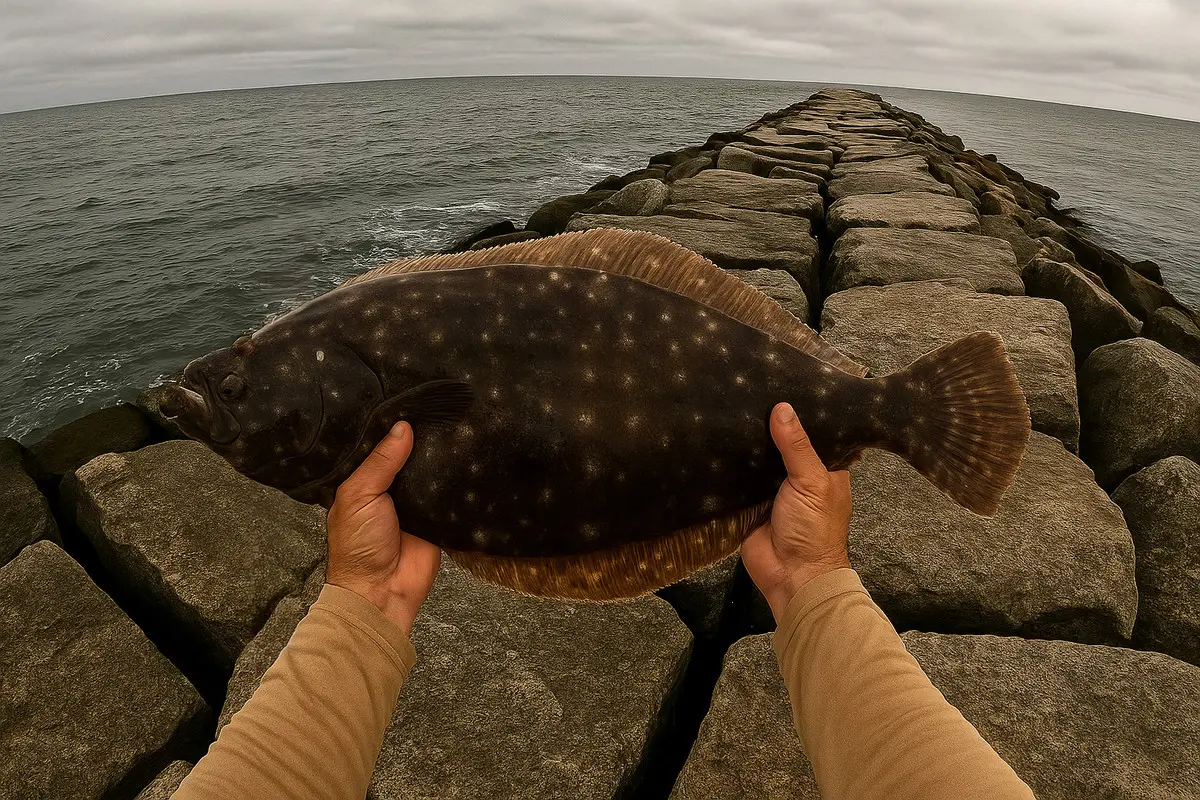Fishing for Flounder in Inlets, Jetties, and Piers

The Complete Guide to Fishing for Flounder in Inlets, Jetties, and Piers
Understanding Structure and Behavior
Flounder are ambush predators that hide along the bottom near structure—jetty rocks, pilings, drop-offs, and current seams—waiting for bait to drift by. They prefer areas where current meets slack water, allowing them to feed efficiently. Look for sandy pockets beside rocks, pier pilings, or channel edges where tidal flow pushes baitfish and shrimp.
Prime Seasons and Conditions
- Spring (Apr–Jun): Fish move inshore to feed before spawning.
- Fall (Sep–Nov): Peak season—flounder stack up near inlets before migration.
- Best tides: First two hours of incoming or last two of outgoing.
- Best times: Dawn and dusk during moving water.
- Water clarity: Slightly stained (1–3 ft visibility) ideal.
Productive Rigs and Lures
1. Carolina Rig (Live Bait Standard)
- Egg sinker: ¼–1 oz
- Leader: 18–24" fluorocarbon (20 lb)
- Hook: 1/0–4/0 Kahle or wide gap
- Keeps bait near bottom with natural movement—perfect for pilings and channel edges.
2. Fish-Finder Rig (Strong Currents)
- Sinker: 1–4 oz pyramid or bank
- Leader: 20–30"
- Hook: 1/0–4/0
- Slides freely, letting fish run before feeling weight.
3. Bucktail Jig (Top Artificial)
- ¼–1 oz in white, chartreuse, or pink, tipped with Gulp! or bait strip.
- Hop slowly along bottom near structure.
- Most bites come on the pause.
4. Knocker Rig (For Snaggy Bottoms)
- Egg sinker sits directly on hook eye—maximum sensitivity for rocky jetties.
5. Double-Hook Rig (For Short Strikes)
- Two hooks spaced 3–4" apart—head and tail of baitfish.
- Improves hookups on large or cautious fish.
Best Baits and Hooking Tips
- Finger mullet: #1 choice—hook through lips or behind dorsal.
- Mud minnows: Hardy and ideal in calmer current.
- Live shrimp: Hook through horn; best in spring/fall.
- Pinfish/croakers: For targeting bigger fish.
- Cut bait: Strips of mullet or menhaden for scent in murky water.
Hooking method: Wait a few seconds after first bump—flounder inhale and turn bait head-first before swallowing.
Key Techniques
1. Slow Drag
- Cast upcurrent, let bait sink, then slowly crawl along bottom.
- Pause often near rocks, pilings, or drop-offs.
- Too fast = missed strikes.
2. Vertical Jigging
- Drop directly beside pilings or jetty edges.
- Lift 6–12" and let fall; strikes often come as jig drops.
3. Drift and Drag
- From boat or while wading—let current move bait naturally along channel edges.
- Maintain bottom contact at all times.
4. Stationary Fishing
- Cast live bait to structure and wait 5–10 minutes before moving.
- On the strike: let fish take 5–10 seconds, then sweep set firmly.
5. Walk-and-Work (Jetty/Pier Search)
- Move every few casts along structure.
- Cast parallel to rocks or along pier pilings.
- Focus on corners, current seams, and holes behind rocks.
Location Strategies
Inlets
- Fish edges of main channel where current slows.
- Outgoing tide: bait flushed seaward; focus on drop-offs.
- Incoming tide: work ocean side edges.
Jetties
- Cast parallel to rocks; bounce bait between boulders.
- Heavier leader (25–30 lb) helps avoid cut-offs.
- Prime spots: jetty tips, current seams, and darker holes.
Piers
- Drop jigs or baits around pilings, especially on the upcurrent side.
- Pier ends = deeper water, more fish.
- Early morning/evening avoids crowds and heat.
Water and Weather Factors
- Tide: Moving water = active fish; slack tide = slow bite.
- Clarity: Slight stain best; clear water demands lighter tackle.
- Wind: Light (5–10 mph) ideal; fish leeward side in heavy wind.
- Temperature: 65–75°F = peak feeding window.
Detecting and Setting the Hook
- Tap-tap or heaviness: Flounder has bait—wait briefly.
- With J-hooks: Reel tight, sweep rod sideways.
- With Circle hooks: Don’t jerk—reel steadily to set.
- Maintain steady pressure; soft mouths tear easily.
Fighting and Landing
- Flounder fight with steady drag, not runs.
- Keep rod at 45° and constant tension.
- Use a net or drop net for landing from pier or rocks—never lift by line.
- Expect sudden surface shakes—keep line tight.
Troubleshooting
- No bites: Slow down, check current, target structure, use livelier bait.
- Short strikes: Add trailer hook or wait longer before setting.
- Snags: Use lighter jigs, change angles, lift gently over rocks.
- Pulled hooks: Back off drag and avoid hard hooksets.
Advanced Tips
- Add scent (Gulp! spray or Pro-Cure) to jigs for more hits.
- Use double jig rigs to cover two depths.
- Try night fishing under pier lights with glow baits.
- “Walk-back technique”: cast out, let bait settle, slowly back up to drag it naturally.
- Flounder love sand-to-rock transitions—feel for them with your line.
Key Takeaway:
Success around inlets, jetties, and piers comes from fishing structure slowly, staying in contact with the bottom, and letting the flounder come to you. Patience and precision beat power every time.
The World's Most Complete Fishing Resource
We're building the ultimate fishing encyclopedia—created by anglers, for anglers. Our articles are created by real experienced fishermen, sometimes using AI-powered research. This helps us try to cover every species, technique, and fishing spot imaginable. While we strive for accuracy, fishing conditions and regulations can change, and some details may become outdated or contain unintentional inaccuracies. AI can sometimes make mistakes with specific details like local access points, parking areas, species distributions, or record sizes.
Spot something off? Whether it's an incorrect boat ramp location, wrong species information, outdated regulations, or any other error, please use the "Help Us Improve This Page" section below. Your local knowledge makes this resource better for every angler.
Explore Related Topics
Discover more articles to deepen your knowledge
Curating articles for you...
Create your own Research Page using AI
Try our AI assistant for free—sign up to access this powerful feature